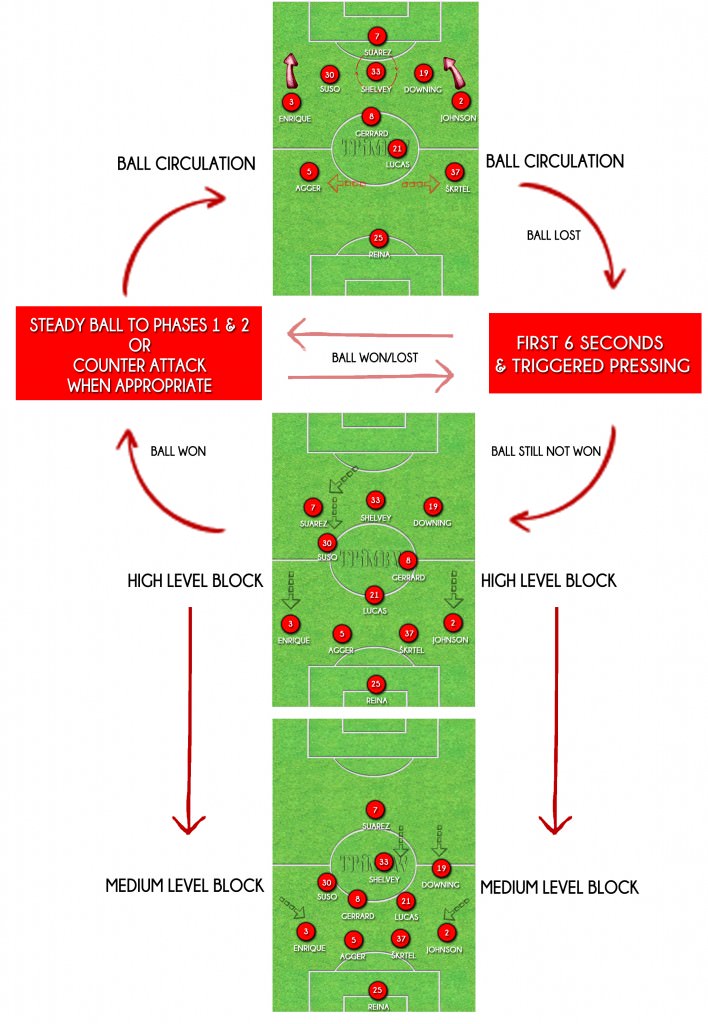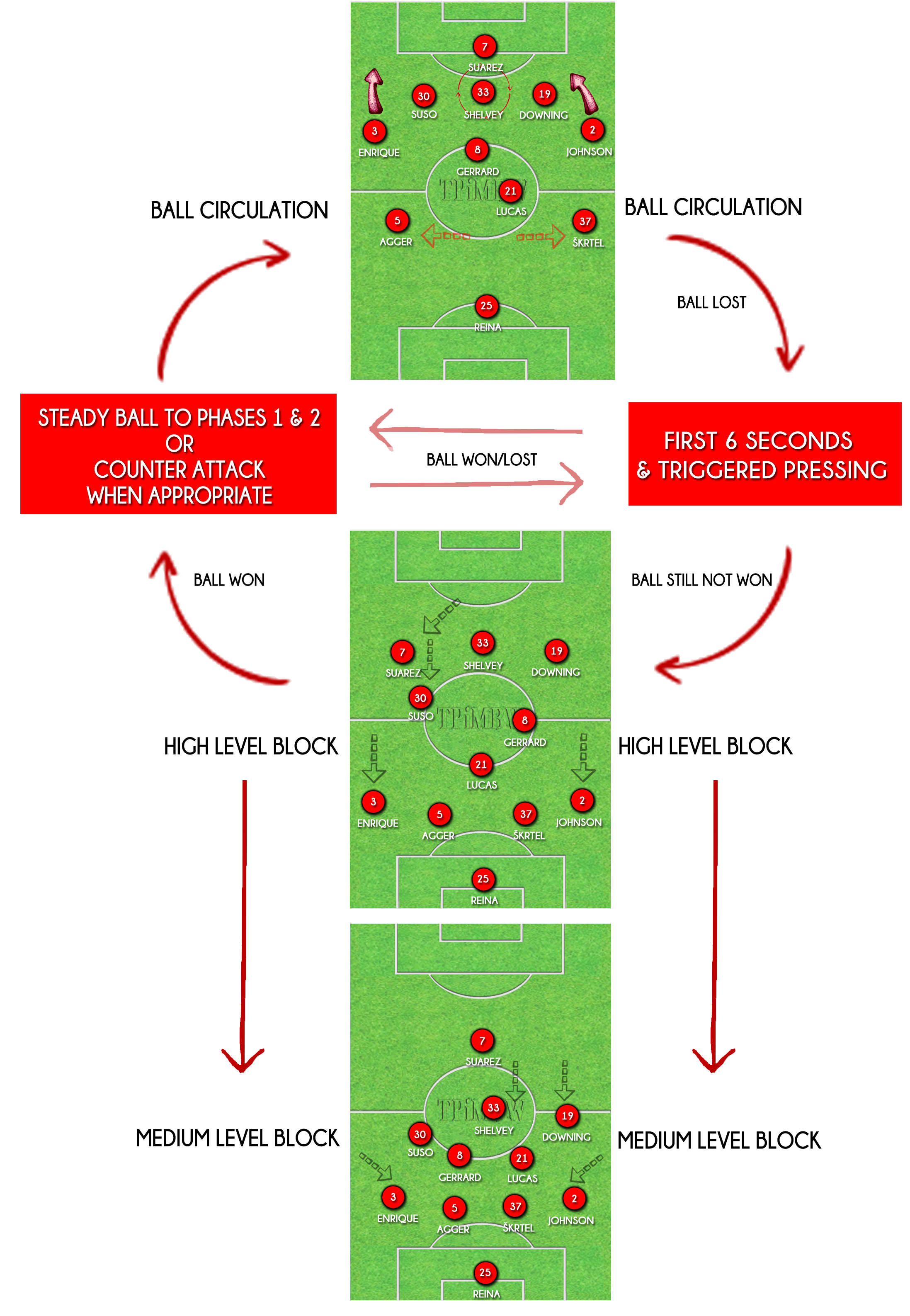Liverpool’s game against Fulham demonstrated, in my opinion, the highest level of performance under Brendan Rodgers to date – and not because of the 4 – 0 score line, but because of the way in which the players executed the phases of play that Rodgers and his coaching staff propose to the Liverpool players every day at Melwood.
Much of the content in the following article includes themes, concepts and ideas that are discussed in the tiki-taka handbook (*due release February 2013 in two parts), and some of the quotes or concepts mentioned in this article are directly taken from personal interviews (Liverpool FC, Barcelona B, Barcelona-USA and a number of other coaches in the game – some of who cannot be quoted here as permission is only given for the book).
Liverpool and their coaching staff propose a system of play that works around four phases:
- ball circulation
- positioning without the ball [otherwise known as the block]
- the transition of losing the ball
- the transition of winning the ball.
Each of these four states are purposefully isolated and put back together at Melwood under the guidance of Brendan Rodgers, Mike Marsh and co. I consider these four phases to be part of a footballing ‘ecosystem’ that is brought to life during the course of a game.
One way in which Liverpool aim to thrive within this ecosystem is by exploiting formation changes within a game to deal with each of the states listed above. For example, Liverpool do not play with a static 4-3-3 (or 4-2-3-1) formation, as almost every pundit will suggest. In fact the only time Liverpool slipped into anything of the sort (against Fulham) was when they were in their most defensive state (the medium-level block).
So instead of immediately introducing you to the formations that Liverpool employed to facilitate their ecosystem of play (the four phases) and their relationship to one another, I want you to envisage the concept of a formation and how you should decide what formation your team plays. I haven’t played football for a season or two, but the last team that I played for (a Gloucestershire County Football League side – a good standard at the top end of the amateur levels) the approach to formation was simply one of 4-4-2 in which players should reposition themselves back into the three lines whenever possible after being directly involved in a function of play (i.e. a winger running down the wing or full-back overlapping etc).
This leads to a way of playing in which the players are the agent of change. That is to say, if the manager felt a team had a particular tactical issue (not keeping the ball well enough), then it would mean a substitution would be the method to change the game. Therefore the static formation is one based on functional rationale and is a relatively non-adaptable strategy. This quite literally is a ‘form(ation) follows function’ (a famous architectural philosophy) approach to football, one where we start by having fixed ideas about how a team should cater specific functions of play.
Brendan Rodgers, his coaching staff and many others within football have instead opted to go for an alternative approach, one which Mick Pearce (one of my favourite architects) employs, a system of design where ‘form follows process’ and his does this to empower adaptability in design.
If the processes of football are each of the four phases introduced earlier in the article then the functions are the individual isolated parts of the game like crossing, a through ball etc. Some teams really do design their strategy of play around a fast winger and towering striker up front to ‘get on the end of it’. By opting for the alternative, you have a system of play where the formation is the agent of change rather than the players. In other words, if you can’t get a grip on possession, you can drop a central midfielder back into a deeper role as a secondary controller (as the Liverpool coaching staff put it to me on my visit to Melwood in November) – Lucas and Gerrard against Fulham or Busquets and Xavi against Manchester United in the 2009 Champions League final (a game where Xavi was purposefully dropped back to regain control of the ball). By dropping a player deeper you leave the opposition with a choice – to push on and still mark the player closely and leave a one-on-one situation further behind or allow the player who has dropped deep with the space.
This article will focus only on the positioning and formation changes that occur within the ‘form follows process’ approach to football. Barcelona, who also play with a ‘form follows process’ approach, are incredibly successful in the transitional phases, and the quicker a team can work through these transitions (i.e. the quicker a team can press or regain control of the ball) the more successful the team will be at being in the correct positions to either circulate the ball or set up their block (not to be confused with ‘parking the bus!’).
[quote]As you will be aware, during a game, FC Barcelona tend to excel when in ‘transition’. However, La Masia coach Sergi Domenech informed me that FC Barcelona try to avoid playing in transition. FC Barcelona see transition as time lost. FC Barcelona are either attacking or defending and are NOT in transition.
Gareth Richards (a coach who studied at La Masia)[/quote]
The two phases of ball circulation and setting up the block are anything but simple solutions and there are thousands of approaches to each of these processes. Sometimes in games we will see two different types of block being used, as we did against Fulham. Against Fulham, Liverpool pressed immediately on losing the ball and depending on where possession was lost, they slipped into one of two types of block (high or medium level blocks – both seen in the eco-system diagram in this article).
Liverpool would then be disciplined in their block and press only when one of the many triggers occurred (i.e. a Fulham player momentarily loses control of the ball). Upon winning the ball back, Liverpool would significantly change formation and work through the transitions into the desired ball circulation state further up field – the central defenders would spread right out onto the touch lines, the full-backs would become wingers, one controller in central midfield would drift in and out of the centre back role and so on. The second goal Liverpool scored, was an absolute masterclass in how the transition from a block to the attacking phases of ball circulation can lead to an unstoppable level of off-ball movement as players drive on forward.
[quote]Good ball circulation puts high demands on the quality of positional play, the mastering of the tempo and the speed of action
Brendan Rodgers[/quote]
One of the areas that Liverpool are still yet to fully master is what Juan Luis Delgado would call ‘identifying the moment of disruption’. On a number of occasions the ball was lost in a hopeful and impatient ball played around the Fulham 18-yard box.
Before Brendan Rodgers became Liverpool manager he announced how his approach of football worked:
[quote]
My template for everything is organisation. With the ball you have to know the movement patterns, the rotation, the fluidity and positioning of the team. Then there’s our defensive organisation…so if it is not going well we have a default mechanism which makes us hard to beat and we can pass our way into the game again. Rest with the ball. Then we’ll build again.
Brendan Rodgers
[/quote]
It is now clear that the positional and formation changes that occur under Rodgers are designed into the ecosystem of play to aid not just the attacking phases of play but also all the other phases of play – which you will see in the diagram at the end of this article.
It is only now that I fully understand some of the things that Johan Cruyff would underline so often, and it is only now that I have the full appreciation for the level of thinking behind the possession-based strategy of play that Brendan Rodgers and others have spent their entire lives studying and finding ways to get their ideas across to players in the most simple and easy to understand methods possible.
[quote]
Playing simple soccer is the most difficult thing of all
Johan Cruyff
[/quote]
In the ecosystem diagram below there are a number of things to take away. When in possession (ball circulation) Liverpool’s formation is something of a 2-2-5-1 formation (if that exists in the rationalised way of thinking that exists), and it is notable just how high up the field Jonjo Shelvey plays; he is now considered an out and out ‘number 10’ player behind the centre forward who drifts in and out of the attacking midfield role and that of the striker role.
Interestingly, when Liverpool dropped into the high-block after losing the ball in the Fulham half, it was identified that they would drop into a front line of three consisting of Suarez, Shelvey and Downing – meaning Suso becomes the third midfielder as he drops back.
Finally, in the medium-block that we saw more often in the second half, Liverpool drop back into three lines of play behind the ball (defence, the two controller midfielders and the advanced midfield line) and Suarez left ahead of the ball as a methodology to improve Liverpool’s ability to counter attack should they see appropriate to do so (when the ball forward allows Liverpool to outnumber the Fulham defenders).
After watching Liverpool v Fulham, I was left with the unfamiliar feeling that Liverpool had the correct player profiles for each of the positions in the system and that the likes of Downing really excelled. If a level of consistency can be found with the eleven players who started against Fulham, it is going to be increasingly difficult for any other player to break into the first eleven – other than Sterling. However, even with the introduction of Sterling into the first eleven unbalances the team in a defensive sense (Suso’s unselfish movement).
I am not one for predicting how things will develop under Rodgers at Liverpool, but one thing is now certain: with the introduction of one or two other key players, Rodgers will have both adaptability in the positional system of play he employs and the profile of players to fit within each of the roles. This will hopefully lead to Rodgers being in a position to have more solutions to tactical problems than he has done over the last three months but more than that, an organism of players who are beginning to understand Rodgers and his philosophy of play.
ECOSYSTEM OF PLAY
 PLEASE SIGN UP TO www.thepathismadebywalking.com’s newsletter for the latest information on the book’s release date – you will receive no other mail other than that one email (probably in January)
PLEASE SIGN UP TO www.thepathismadebywalking.com’s newsletter for the latest information on the book’s release date – you will receive no other mail other than that one email (probably in January)

